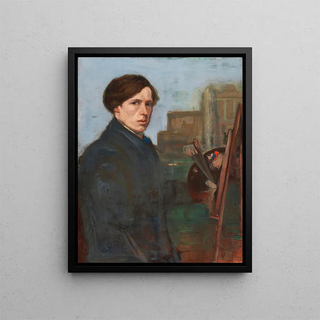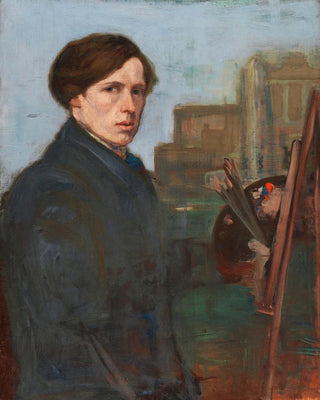Painting Portrait of William Orpen 1878-1931 artist - Charles Conder | Art print


View from behind

Frame (optional)
In the vast universe of art, some works stand out for their ability to capture not only the appearance of a subject but also its essence. The "Portrait of William Orpen" created by Charles Conder is a striking example. This painting, which transcends the simple portrait, invites the viewer to delve into the intimacy of a moment frozen in time. Through the depiction of this Irish artist, Conder does not merely portray a face; he evokes a personality, an era, and a dialogue between two creators. This piece, with its depth and complexity, is a true testament to the richness of art in the early 20th century.
Style and uniqueness of the work
Charles Conder's style is often associated with Impressionism, but his approach to the art print goes far beyond this movement. In "Portrait of William Orpen," Conder uses vibrant colors and subtle lighting to bring his subject to life. The brushstrokes, both delicate and bold, create a texture that feels almost tangible. The background, blurred and suggestive, highlights the main character without distracting. This stylistic choice allows the viewer to focus on Orpen's features, where every detail, from the penetrating gaze to the pensive expression, tells a story. The composition is carefully balanced, and the harmony of colors enhances the emotion conveyed by the art print. Conder succeeds in establishing a connection between the artist and the viewer, making the work both personal and universal.
The artist and his influence
Charles Conder, an emblematic figure of the Australian Impressionist movement, managed to leave his mark on his era with his unique vision and undeniable talent. Born in 1868 in London, he emigrated to Australia, where he quickly gained notoriety as a landscape and portrait painter. His friendship with William Orpen, another great name in art, was decisive in his artistic journey. Orpen, recognized for his striking portraits, influenced Conder in his approach to human representation. Together, they shared ideas, techniques, and a passion for art.

Matte finish

View from behind

Frame (optional)
In the vast universe of art, some works stand out for their ability to capture not only the appearance of a subject but also its essence. The "Portrait of William Orpen" created by Charles Conder is a striking example. This painting, which transcends the simple portrait, invites the viewer to delve into the intimacy of a moment frozen in time. Through the depiction of this Irish artist, Conder does not merely portray a face; he evokes a personality, an era, and a dialogue between two creators. This piece, with its depth and complexity, is a true testament to the richness of art in the early 20th century.
Style and uniqueness of the work
Charles Conder's style is often associated with Impressionism, but his approach to the art print goes far beyond this movement. In "Portrait of William Orpen," Conder uses vibrant colors and subtle lighting to bring his subject to life. The brushstrokes, both delicate and bold, create a texture that feels almost tangible. The background, blurred and suggestive, highlights the main character without distracting. This stylistic choice allows the viewer to focus on Orpen's features, where every detail, from the penetrating gaze to the pensive expression, tells a story. The composition is carefully balanced, and the harmony of colors enhances the emotion conveyed by the art print. Conder succeeds in establishing a connection between the artist and the viewer, making the work both personal and universal.
The artist and his influence
Charles Conder, an emblematic figure of the Australian Impressionist movement, managed to leave his mark on his era with his unique vision and undeniable talent. Born in 1868 in London, he emigrated to Australia, where he quickly gained notoriety as a landscape and portrait painter. His friendship with William Orpen, another great name in art, was decisive in his artistic journey. Orpen, recognized for his striking portraits, influenced Conder in his approach to human representation. Together, they shared ideas, techniques, and a passion for art.
12,34 €






